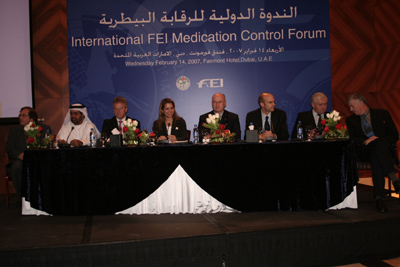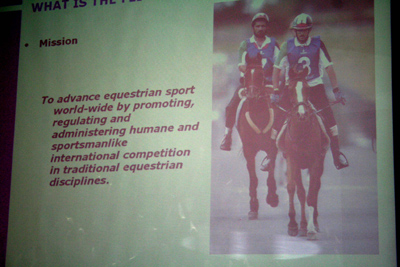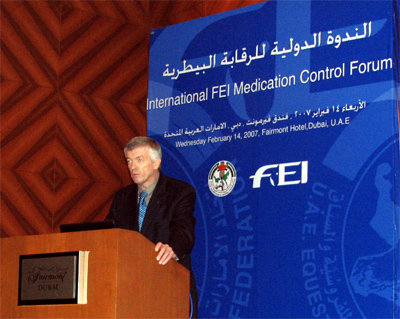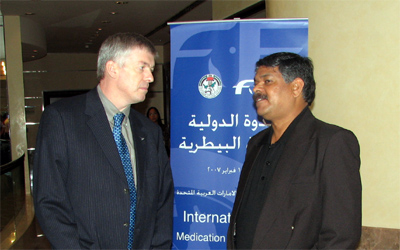FEI International Forum on Medicaton Control |
Full UAE Event Coverage |
 February 14, 2007
February 14, 2007Fairmont Hotel, Dubai UAE The first FEI forum on equine medication control was opened by FEI Secretary General, Michael Stone. He introduced the speakers, thanked everybody for their presence at this important meeting, and explained the purpose of the forum: to educate riders, trainers, veterinarians and officials, and to create an open dialogue between FEI and the equestrian sport community. The forum would include a series of slide presentations by various FEI officers and staff and an open discussion session, with opportunity for questions and concerns to be aired. HRH Princess Haya Bint Al Hussein, President of the FEI, would be in attendance at the forum, to share in the goal of education and dialog between the FEI, the governing body of International Equestrian sport, and equestrian community - those whose lives, sports and careers are integral to the future of the sport. Several individuals who have been involved in sport for years, including Dr. Jim Bryant, helped to persuade the FEI and the UAE Equestrian Federation that this would be a good time and place (just before the Presidents Cup in the UAE) to initiate a forum of this type. The room was packed- the forum was well attended. The lineup of speakers included FEI officers, veterinarians and lawyers. The problems of illegal medication of the horse in FEI competition are complicated, and positives arise due to both ignorance and deliberate intent to alter the horse's performance. The FEI recognizes the difference between the two, and whereas all positives must be addressed, the real problem that they must wrestle with is the proliferation of new performance enhancing drugs, and the lag time in developing effective testing methods.  Dr. Fritz Sluyter of the FEI Veterinary Department was the first speaker. He addressed the nuances of Endurance competition, a sport in which the horse may have many years of intensive competition and training, in addition to the significant stress of transport to and from events. Thus, the Endurance horse may have more need for medication in the course of its career.
The rules regarding medication in FEI Endurance competitions have progressed from permitted levels of certain substances (e.g. bute) prior to 1992, to the current 'zero' tolerance standard. But while the term 'zero tolerance' is philosophically correct, it is a misnomer since certain medications and substances are permitted such as dewormers, antibiotics, gastric ulcer medications and hormone regulating drugs for mares.
Dr. Fritz Sluyter of the FEI Veterinary Department was the first speaker. He addressed the nuances of Endurance competition, a sport in which the horse may have many years of intensive competition and training, in addition to the significant stress of transport to and from events. Thus, the Endurance horse may have more need for medication in the course of its career.
The rules regarding medication in FEI Endurance competitions have progressed from permitted levels of certain substances (e.g. bute) prior to 1992, to the current 'zero' tolerance standard. But while the term 'zero tolerance' is philosophically correct, it is a misnomer since certain medications and substances are permitted such as dewormers, antibiotics, gastric ulcer medications and hormone regulating drugs for mares.
 The philosophy behind the strict regulation of medication in Endurance horses is based upon the concept of the welfare of the horse. In equine sports, the equine is the silent partner; while human athletes can elect to medicate, the horse cannot. Abuse and over-use of medications must be prevented, as well as the administration of substances that can mask an existing unfitness or illness. Another reason for strict medication control is to assure a fair playing field to all. There must be no influence of substances on competition results.
At the Athens Olympics in 2004, several medal winning horses tested positive for drugs. There were cases of new medications (human psychotic drugs were detected for the first time) and also tampering with samples. The medals were stripped and a medications task force was created to move the FEI forward. Stricter legal controls were put in place to protect all parties and the FEI determined to pursue even stricter control of prohibited substance. Several rules changed after the event regarding legal avenues and repercussions, but the FEI position on drugs did not essentially change. It is recognized that horses may need treatment during their careers for various reasons, but a horse that may need treatment in order to compete, should simply not complete.
There are cases and conditions where medication of the horse is acceptable to the FEI, but in all cases the authorization of medication is only granted if the horse is still fit to compete, and if the medication grants no unfair advantage. FEI officiating veterinarians must process all medications in this manner with a form - Medication Form 1 - prior to administration. Under certain circumstances, retroactive authorization is possible, for such conditions as wounds incurred during transport, or the need to sedate or treat for colic, shipping fever, etc. In all cases the decision may be made by the official Veterinarian, and signed off by the Ground Jury.
The philosophy behind the strict regulation of medication in Endurance horses is based upon the concept of the welfare of the horse. In equine sports, the equine is the silent partner; while human athletes can elect to medicate, the horse cannot. Abuse and over-use of medications must be prevented, as well as the administration of substances that can mask an existing unfitness or illness. Another reason for strict medication control is to assure a fair playing field to all. There must be no influence of substances on competition results.
At the Athens Olympics in 2004, several medal winning horses tested positive for drugs. There were cases of new medications (human psychotic drugs were detected for the first time) and also tampering with samples. The medals were stripped and a medications task force was created to move the FEI forward. Stricter legal controls were put in place to protect all parties and the FEI determined to pursue even stricter control of prohibited substance. Several rules changed after the event regarding legal avenues and repercussions, but the FEI position on drugs did not essentially change. It is recognized that horses may need treatment during their careers for various reasons, but a horse that may need treatment in order to compete, should simply not complete.
There are cases and conditions where medication of the horse is acceptable to the FEI, but in all cases the authorization of medication is only granted if the horse is still fit to compete, and if the medication grants no unfair advantage. FEI officiating veterinarians must process all medications in this manner with a form - Medication Form 1 - prior to administration. Under certain circumstances, retroactive authorization is possible, for such conditions as wounds incurred during transport, or the need to sedate or treat for colic, shipping fever, etc. In all cases the decision may be made by the official Veterinarian, and signed off by the Ground Jury.
 One of the challenges that FEI faces is that of testing. There are 4 labs around the world that will test blood and urine samples from FEI competing horses: Paris, France (the main lab), Ithica (NY) USA, Hong Kong, and Sydney Australia. The FEI is working towards 'harmonization' of these labs so that all will use the same testing procedures and return the same results for any given sample. The FEI is continuing to move closer to WADA (World Anti-Doping Agency) standards. To this end, Olympic involvement is essential for the FEI.
The major consequence of the Athens Olympics scandal, and the initiation of the Task Force for Medication, was an FEI mandate to rebuild the FEI legal department and revise all rules pertaining to the medication issue. From this came stronger sanctioning for positives, including fines, disqualification and suspension. FEI determined that it was imperative that veterinarians, trainers and athletes not respecting the sport must be brought back in line, and there must be tightly defined rules and definitive regulations to abide by.
There would be no more reference to 'zero tolerance', instead clear establishment of detection times on the most preferred medications would be published. Veterinarians would be able to formulate treatment regimes, and predict safe withdrawal times based upon clearly defined detection times for each drug.
One of the challenges that FEI faces is that of testing. There are 4 labs around the world that will test blood and urine samples from FEI competing horses: Paris, France (the main lab), Ithica (NY) USA, Hong Kong, and Sydney Australia. The FEI is working towards 'harmonization' of these labs so that all will use the same testing procedures and return the same results for any given sample. The FEI is continuing to move closer to WADA (World Anti-Doping Agency) standards. To this end, Olympic involvement is essential for the FEI.
The major consequence of the Athens Olympics scandal, and the initiation of the Task Force for Medication, was an FEI mandate to rebuild the FEI legal department and revise all rules pertaining to the medication issue. From this came stronger sanctioning for positives, including fines, disqualification and suspension. FEI determined that it was imperative that veterinarians, trainers and athletes not respecting the sport must be brought back in line, and there must be tightly defined rules and definitive regulations to abide by.
There would be no more reference to 'zero tolerance', instead clear establishment of detection times on the most preferred medications would be published. Veterinarians would be able to formulate treatment regimes, and predict safe withdrawal times based upon clearly defined detection times for each drug.
 There is currently a list of detection times for some commonly used drugs on the FEI website (www.horsesport.org) and more drugs are currently being research in order to publish detection times - a total of 17 drug detection times will be available on the website by years end. This 'Medicine Box' will make it easier for veterinarians to treat horses for normal minor conditions and enable them to determine safe competition withdrawal times.
Another challenge the FEI faces is that of adaptation to newly formulated drugs. When new drugs are suspected, new testing methods must be developed. Some substances may have threshold levels of acceptability, some substances must be sanctioned at any level.
There is currently a list of detection times for some commonly used drugs on the FEI website (www.horsesport.org) and more drugs are currently being research in order to publish detection times - a total of 17 drug detection times will be available on the website by years end. This 'Medicine Box' will make it easier for veterinarians to treat horses for normal minor conditions and enable them to determine safe competition withdrawal times.
Another challenge the FEI faces is that of adaptation to newly formulated drugs. When new drugs are suspected, new testing methods must be developed. Some substances may have threshold levels of acceptability, some substances must be sanctioned at any level.
 Lab harmonization is currently being undertaken, so that the calculation of IUC (ineffective urine concentration) and IPC (ineffective plasma concentration) is the same for all four of the FEI approved testing labs. Results must be consistent regardless of the lab to which samples are sent.
While detection times for several drugs will be published, treating veterinarians must not rely entirely on this data to determine save withdrawal times. Many factors may affect withdrawal times (time after administration after which no significant level of detection can be made) and must be calculated: individual differences in horse metabolism, the effect of administering more than one drug (cocktails) at a time, etc. Lab harmonization is currently being undertaken, so that the calculation of IUC (ineffective urine concentration) and IPC (ineffective plasma concentration) is the same for all four of the FEI approved testing labs. Results must be consistent regardless of the lab to which samples are sent.
While detection times for several drugs will be published, treating veterinarians must not rely entirely on this data to determine save withdrawal times. Many factors may affect withdrawal times (time after administration after which no significant level of detection can be made) and must be calculated: individual differences in horse metabolism, the effect of administering more than one drug (cocktails) at a time, etc.
FEI wants everybody on the same side of fence - team vets appointed by NF's, owners, riders, private vets, veterinary delegates, FEI veterinary commission officials. All must understand the importance of complying with WADA guidelines, and keeping the sport clean and acceptable. Endurance must stay acceptable for the participants, and also the public, media and sponsors.  A few details and numbers:
A few details and numbers: In 2006 FEI spent over 1 million (swiss francs) on drug testing in all disciplines. The number of events tested, horses tested, and positives was up from previous years. The number of positives was even higher than in the racing industry. Many, if not most, of the positives resulted from ignorance, where the withdrawal times of certain drugs was not adequate - medications were given too close to the event. And while in most of the cases there was no longer a pharmacological effect of the drug, i.e. no performance enhancing or pain masking effect, the detection level was still too high.  The most commonly detected drugs were NSAIDs (non-steroidal anti-inflammatory drugs) and tranquilizers - both for management (e.g. clipping) and for performance enhancement. Also detected were corticosteroids (systemic and intra-articular), caffeine, isoxsuprine, and respiratory drugs,
Disciplines which had the highest number of positives were: Jumping (26), Endurance (14) and Eventing (6). But these numbers are not based upon percentages of positives within each sport, rather a sampling of all events within the discipline. Since Jumping (and secondly Endurance) events are far more common than the other disciplines, they also registered the highest number of tests.
Ian Williams, FEI Director of Endurance spoke on the rules pertaining to medication. Rules specific to events, to competitions (each event may have several competitions), to veterinarians. He addressed the practical applications of the rules, and the supporting documentation. The most commonly detected drugs were NSAIDs (non-steroidal anti-inflammatory drugs) and tranquilizers - both for management (e.g. clipping) and for performance enhancement. Also detected were corticosteroids (systemic and intra-articular), caffeine, isoxsuprine, and respiratory drugs,
Disciplines which had the highest number of positives were: Jumping (26), Endurance (14) and Eventing (6). But these numbers are not based upon percentages of positives within each sport, rather a sampling of all events within the discipline. Since Jumping (and secondly Endurance) events are far more common than the other disciplines, they also registered the highest number of tests.
Ian Williams, FEI Director of Endurance spoke on the rules pertaining to medication. Rules specific to events, to competitions (each event may have several competitions), to veterinarians. He addressed the practical applications of the rules, and the supporting documentation.
 Rules pertaining to competitions: Competition officially starts 1 hour before first horse inspection and finishes 2 hours after crossing the finish line
Finishes 2 hours after crossing finish line, unless horse is entered for BC, in which case the horse is considered 'in competition' until after the BC judging. Horses may be selected for testing at any time during the competition. In cases where horses are not stabled on competition grounds they must be subject to random visits by officials. (e.g. if the horse is brought to the grounds for inspection, and then transported back to it's stable until the actual start of the competition).
There are 3 possible methods of selection of horses to be tested:
Medal winners (3), random method, and spot testing.
In all cases there is comparison of results and review based upon any and all Medication Forms submitted by the treating veterinarian and approved by the Ground Jury. The Medication Forms provide authorization for the use of non-prohibited substances. Rules pertaining to competitions: Competition officially starts 1 hour before first horse inspection and finishes 2 hours after crossing the finish line
Finishes 2 hours after crossing finish line, unless horse is entered for BC, in which case the horse is considered 'in competition' until after the BC judging. Horses may be selected for testing at any time during the competition. In cases where horses are not stabled on competition grounds they must be subject to random visits by officials. (e.g. if the horse is brought to the grounds for inspection, and then transported back to it's stable until the actual start of the competition).
There are 3 possible methods of selection of horses to be tested:
Medal winners (3), random method, and spot testing.
In all cases there is comparison of results and review based upon any and all Medication Forms submitted by the treating veterinarian and approved by the Ground Jury. The Medication Forms provide authorization for the use of non-prohibited substances.
 Treatment and treatment authorization must be givein in emergency situations only, with the understanding that any such treatment cannot give a horse an unfair advantage. If clinical signs are serious, horse must be simply be withdrawn.
Guidelines for authorization via Medication Forms must be clear. Considerations for authorization include: will horse recover in time? What is treatment of preference, what is the period of pharmacological activity? What are the withdrawal times? Is there need for 'cocktail' treatment' or combing several drugs (which makes the situation more complicated, less predictable). Is this horse still 'fit to compete', fit for inspection?
Treatment and treatment authorization must be givein in emergency situations only, with the understanding that any such treatment cannot give a horse an unfair advantage. If clinical signs are serious, horse must be simply be withdrawn.
Guidelines for authorization via Medication Forms must be clear. Considerations for authorization include: will horse recover in time? What is treatment of preference, what is the period of pharmacological activity? What are the withdrawal times? Is there need for 'cocktail' treatment' or combing several drugs (which makes the situation more complicated, less predictable). Is this horse still 'fit to compete', fit for inspection?
 Acceptable treatment conditions may include minor cuts and bruises, mild transport stress, light colic, tranquillization, eye problems, insect allergic reactions, muscle stiffness, local anesthetics (stitching), electrolyte loss, antibiotics, vitamins. Regumate and Gastroguard are permitted and must be declared. In some disciplines (Eventing) fluids are permitted for dehydration.
Prohibited substances basically fall into 2 categories: Doping: performance enhancing substances not used in normal treatment regimes and Medication: substances used in normal treatment such as local anesthetics and pain killers (Class A), and substances with minimal performance enhancing effects (Class B) such as DMSO and isoxsuprin.
In all cases authorization of treatment must adhere to the Medication Code: all treatments must be given in best health and welfare interests of horse. Acceptable treatment conditions may include minor cuts and bruises, mild transport stress, light colic, tranquillization, eye problems, insect allergic reactions, muscle stiffness, local anesthetics (stitching), electrolyte loss, antibiotics, vitamins. Regumate and Gastroguard are permitted and must be declared. In some disciplines (Eventing) fluids are permitted for dehydration.
Prohibited substances basically fall into 2 categories: Doping: performance enhancing substances not used in normal treatment regimes and Medication: substances used in normal treatment such as local anesthetics and pain killers (Class A), and substances with minimal performance enhancing effects (Class B) such as DMSO and isoxsuprin.
In all cases authorization of treatment must adhere to the Medication Code: all treatments must be given in best health and welfare interests of horse.
 Andrew Higgins presented several slides pertaining to FEI's Antidoping and Medication Policy, and once again reiterated the FEI Mission and FEI Code of conduct - "at all times the welfare of the horse must be paramount and must never be subordinated to competitive or commercial influences. "
He emphasized the responsibility that we have: whereas in human sports, the athlete can make the decision to take drugs, in equine sports the horse has no choice. Doping, or the use of substances which have no place in the normal treatment of horses but may significantly alter a horses performance are considered the 'worst enemy' and of highest concern to FEI. Questions must constantly be asked: Does one encounter manipulation of horses metabolic state? Abnormal recovery rate at vet checks? Eventual lameness masked by medication during competition? Is rider in communication with horse on fatigue? Could prohibited substances stimulate a horse to show better for Best Condition prize? Are effective medication control procedures in place and are they being properly enforcefd?
Andrew Higgins presented several slides pertaining to FEI's Antidoping and Medication Policy, and once again reiterated the FEI Mission and FEI Code of conduct - "at all times the welfare of the horse must be paramount and must never be subordinated to competitive or commercial influences. "
He emphasized the responsibility that we have: whereas in human sports, the athlete can make the decision to take drugs, in equine sports the horse has no choice. Doping, or the use of substances which have no place in the normal treatment of horses but may significantly alter a horses performance are considered the 'worst enemy' and of highest concern to FEI. Questions must constantly be asked: Does one encounter manipulation of horses metabolic state? Abnormal recovery rate at vet checks? Eventual lameness masked by medication during competition? Is rider in communication with horse on fatigue? Could prohibited substances stimulate a horse to show better for Best Condition prize? Are effective medication control procedures in place and are they being properly enforcefd?
 FEI's medication rules evolved from European racing, but FEI sports not same as racing. One sees many older horses, constantly on the circuit, with greater need for medications and treatment. In FEI sports there is no licensing or tight competition infrastructure, and no out of competition testing (with one exception being the French National Team. There are 134 federations participating in FEI sports.
Mr. Higgins outlined the procedures pertaining to testing and sampling. The basic procedure: Rider will be told, Horse will be escorted to testing barn, Horse will enter testing box. Two samples of urine and two samples of blood are collected (A and B). A is analyized immediately, and B is frozen, to be available for result confirmation at a later date. In addition to urine and blood, swab samples may be taken from the body or bandages.
The samples are then sent to one of the four FEI approved labs. In 2006 Federations with the highest number of positives were, in order: Italy, France, USA, Spain and Great Britain. In 2005 it was Italy, USA, UAE, Germany and Syria.
Finally, Alex McLin spoke on the legal process and legal ramifications of positive tests. There are strict procedures which must be followed if a positive is identified beginning with the analysis of the B (secondary) sample. Sanctions and/or fines are eventually levied on individuals based upon the severity of the act. Cases of doping (administering of prohibited substances with the intent to alter performance) are regarded as much more serious and punishable matters than cases of medication.
FEI's medication rules evolved from European racing, but FEI sports not same as racing. One sees many older horses, constantly on the circuit, with greater need for medications and treatment. In FEI sports there is no licensing or tight competition infrastructure, and no out of competition testing (with one exception being the French National Team. There are 134 federations participating in FEI sports.
Mr. Higgins outlined the procedures pertaining to testing and sampling. The basic procedure: Rider will be told, Horse will be escorted to testing barn, Horse will enter testing box. Two samples of urine and two samples of blood are collected (A and B). A is analyized immediately, and B is frozen, to be available for result confirmation at a later date. In addition to urine and blood, swab samples may be taken from the body or bandages.
The samples are then sent to one of the four FEI approved labs. In 2006 Federations with the highest number of positives were, in order: Italy, France, USA, Spain and Great Britain. In 2005 it was Italy, USA, UAE, Germany and Syria.
Finally, Alex McLin spoke on the legal process and legal ramifications of positive tests. There are strict procedures which must be followed if a positive is identified beginning with the analysis of the B (secondary) sample. Sanctions and/or fines are eventually levied on individuals based upon the severity of the act. Cases of doping (administering of prohibited substances with the intent to alter performance) are regarded as much more serious and punishable matters than cases of medication.
 Michael Stone concluded the presentation. The philosophy behind the strict regulation of medication in Endurance horses is based upon the concept of the welfare of the horse. In equine sports, the equine is the silent partner; while human athletes can elect to medicate, the horse cannot. Abuse and over-use of medications must be prevented, as well as the administration of substances that can mask an existing unfitness or illness. In addition strict medication control is paramount to assure a fair playing field to all. There must be no influence of substances on competition results.
A brief open panel discussion followed the presentations in which the speakers and HRH Princess Haya, President of FEI responded to various questions from the audience. The concept of 'Person Responsible' was discussed - the legal term for defining the rider as the person who must be ultimately held responsible and accountable if a horse tests positive. Many of the riders in attendance expressed concern that when riding a foreign horse they may have little or no control over how the horse is managed before or during competition in regards to medication. The answer from the legal department, and reiterated by Princess Haya was that while the issue can be complicated, the FEI still feels that it is ultimately the rider who must be held accountable. It was suggested that a clearly written contract between rider and owner or trainer would be the best mitigation possible for all concerned, but would not change the bottom line: rider is ultimately responsible.
Michael Stone concluded the presentation. The philosophy behind the strict regulation of medication in Endurance horses is based upon the concept of the welfare of the horse. In equine sports, the equine is the silent partner; while human athletes can elect to medicate, the horse cannot. Abuse and over-use of medications must be prevented, as well as the administration of substances that can mask an existing unfitness or illness. In addition strict medication control is paramount to assure a fair playing field to all. There must be no influence of substances on competition results.
A brief open panel discussion followed the presentations in which the speakers and HRH Princess Haya, President of FEI responded to various questions from the audience. The concept of 'Person Responsible' was discussed - the legal term for defining the rider as the person who must be ultimately held responsible and accountable if a horse tests positive. Many of the riders in attendance expressed concern that when riding a foreign horse they may have little or no control over how the horse is managed before or during competition in regards to medication. The answer from the legal department, and reiterated by Princess Haya was that while the issue can be complicated, the FEI still feels that it is ultimately the rider who must be held accountable. It was suggested that a clearly written contract between rider and owner or trainer would be the best mitigation possible for all concerned, but would not change the bottom line: rider is ultimately responsible.
 Other topics were discussed such as reference to positives from horses sharing stalls (e.g. ingesting straw contaminated by urine from a medicated horse previously occupying the stall). There were questions about the use of tranquilizers, which some trainers thought should be permitted as a safety feature to prevent injury to riders whose horses were over-excited at the start of the race. Questions about the practice of re-hydrating Eventing horses during competition by IV drip. The response to this question was an insistence that this practice would never be permitted in Endurance.
The forum was successful and well attended. It was a very important step towards the ethical and practical aspects of adhering to FEI's mission: To advance equestrian sport world-wide by promoting, regulating and administering humane and sportsmanlike international competition in traditional equestrian disciplines. All involved must respect the spirit of, and abide by the rules which provide for the welfare of the horse, and fair play for all competitors. Other topics were discussed such as reference to positives from horses sharing stalls (e.g. ingesting straw contaminated by urine from a medicated horse previously occupying the stall). There were questions about the use of tranquilizers, which some trainers thought should be permitted as a safety feature to prevent injury to riders whose horses were over-excited at the start of the race. Questions about the practice of re-hydrating Eventing horses during competition by IV drip. The response to this question was an insistence that this practice would never be permitted in Endurance.
The forum was successful and well attended. It was a very important step towards the ethical and practical aspects of adhering to FEI's mission: To advance equestrian sport world-wide by promoting, regulating and administering humane and sportsmanlike international competition in traditional equestrian disciplines. All involved must respect the spirit of, and abide by the rules which provide for the welfare of the horse, and fair play for all competitors.
|




